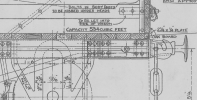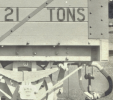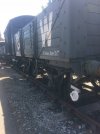Adrian Johnstone
New Member
This is my first post, so I hope I've chosen the right sub-forum. This question is about general modelling practice for small features such as the chamfers on coal wagon on coal wagon sheeting planks.
Prototype chamfers that I've measured come out at around 0.25 to 0.5 inches high and 'not very' deep. The works drawings that I've seen (eg those at Railway Clearing House wagons) do not specify a size - I guess they came out as whatever the spokeshave took off that day.


On RTR models, and in fact even on very high quality scratch models, these chamfers must, I think, be wildly overscale, because people expect to see them even though really they ought to be invisible. For instance, in Gauge 1, a 10mm prototype chamfer would be only 0.32mm wide and deep, and thus barely visible on a model from any distance - that's less than one bead in a 3D printed model using a 0.4mm nozzle.
I make CAD models for Gauge 1 stock (as an aside I'm the owner of the G1 3D Circle forum at home groups.io Group). My CAD models are prototype size, and then I provide a global scale factor that brings things down to, say G1, or 2mm. However, I also provide 'bloat' factors for small features that multiply their size back up again because folk expect to be able to see them. In G1 I use a factors of 2.5-3 for the chamfers which looks fine, but is not accurate.
What do other people do, especially in the smaller scales? If you zoomed your model up to prototype size, how big would the chamfers be? And if we're really serious about fine-scale modelling, where do we draw the line between accuracy and 'artistic license'?
Adrian
* Drawing image from above website
** Photograph from Wikimedia commons at File:BNR coal wagon 17209.jpg - Wikimedia Commons - actually an Indian wagon not a UK RCH wagon
Prototype chamfers that I've measured come out at around 0.25 to 0.5 inches high and 'not very' deep. The works drawings that I've seen (eg those at Railway Clearing House wagons) do not specify a size - I guess they came out as whatever the spokeshave took off that day.


On RTR models, and in fact even on very high quality scratch models, these chamfers must, I think, be wildly overscale, because people expect to see them even though really they ought to be invisible. For instance, in Gauge 1, a 10mm prototype chamfer would be only 0.32mm wide and deep, and thus barely visible on a model from any distance - that's less than one bead in a 3D printed model using a 0.4mm nozzle.
I make CAD models for Gauge 1 stock (as an aside I'm the owner of the G1 3D Circle forum at home groups.io Group). My CAD models are prototype size, and then I provide a global scale factor that brings things down to, say G1, or 2mm. However, I also provide 'bloat' factors for small features that multiply their size back up again because folk expect to be able to see them. In G1 I use a factors of 2.5-3 for the chamfers which looks fine, but is not accurate.
What do other people do, especially in the smaller scales? If you zoomed your model up to prototype size, how big would the chamfers be? And if we're really serious about fine-scale modelling, where do we draw the line between accuracy and 'artistic license'?
Adrian
* Drawing image from above website
** Photograph from Wikimedia commons at File:BNR coal wagon 17209.jpg - Wikimedia Commons - actually an Indian wagon not a UK RCH wagon

 .
.